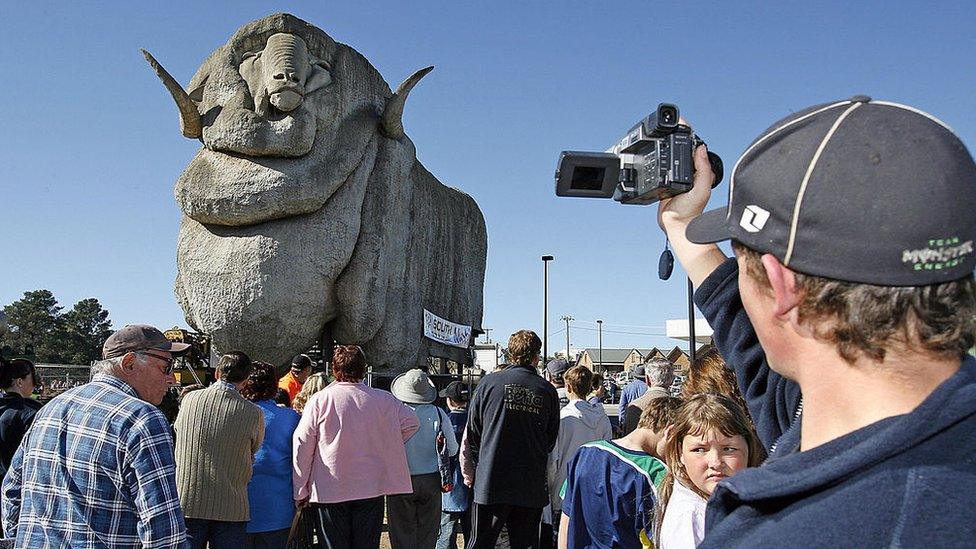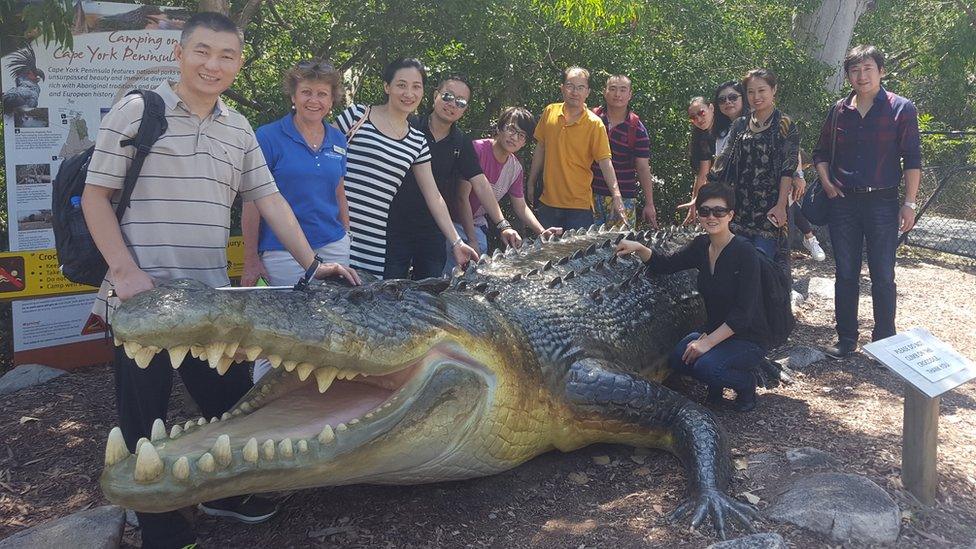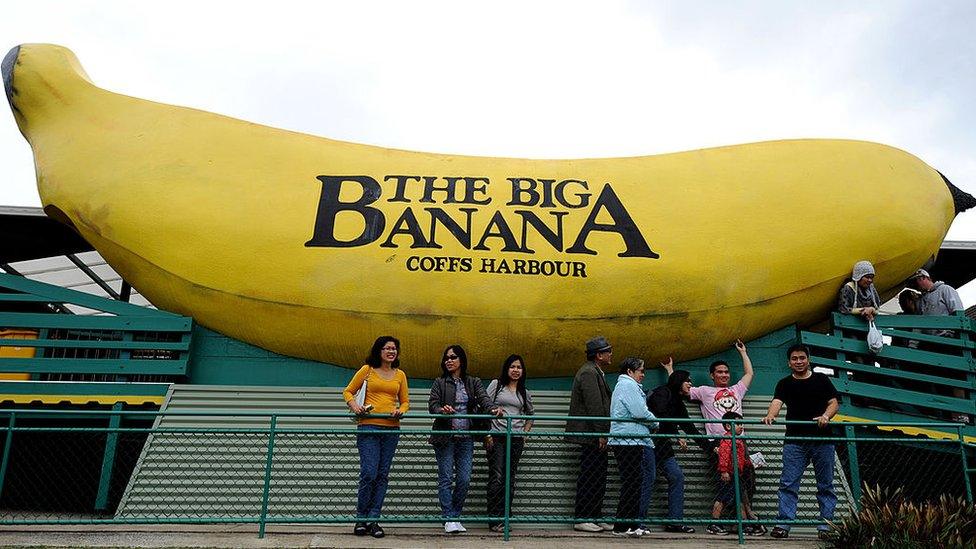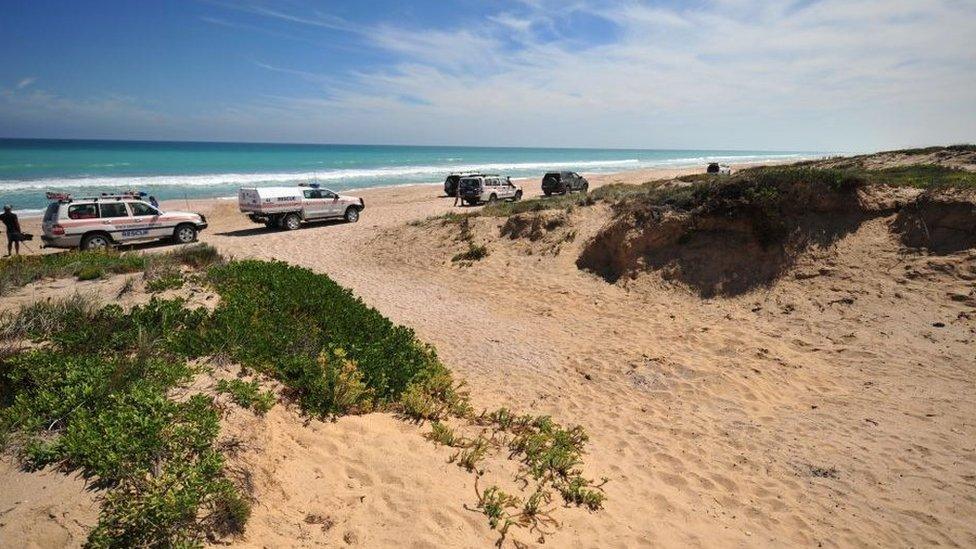Australia's obsession with 'big things'
- Published

The Big Merino is one of many "big" monuments in Australia
In the low-budget 1987 Australian horror film Dark Age, a ranger, played by Wolf Creek star John Jarratt, tracks a rogue saltwater crocodile. Four decades on and the film, or more particularly one of its props, continues to scare and enthral.
At a whopping 9m (30ft) long, Ron the giant fibreglass croc sits proudly at Hartley's Crocodile Adventures at Wangetti Beach in Far North Queensland, which bought the mould for the large reptile from the makers of the movie. Ron is part of the quirky Australian tradition of building big models and monuments, from the Big Banana to the Big Merino and Big Prawn.
Ron has a few metres on the largest real crocodile ever caught in Australia - a 5.48m giant dubbed Cassius. But Angela Freeman, co-owner of Hartley's, says tourists "absolutely love it".
"The little darling has recently been repainted and refurbished, and has brand new glass eyes bought for him," she says. "He's a great attraction."

Ron, a former film prop, is popular among tourists in Far North Queensland
There are dozens of large statues in every Australian state and territory that celebrate a beguiling array of mushrooms, guitars, ants, mosquitoes, worms and the outlaw Ned Kelly, and much more.
A Christian organisation recently announced plans to build a huge illuminated cross on top of a hill in a remote corner of central Australia. It would be about 22m high and be illuminated on land near the Aboriginal community of Ikuntji, 230km (143 miles) west of Alice Springs.
Other monuments salute local produce or industries, such as the 6m Big Miner in Ballarat, while others are marketing gimmicks for shops and motels.
"They pop up all over the place. You're driving along and suddenly you see this 6m-high lobster," says Patti McCarthy, who runs Cultural Chemistry, a company providing cross-cultural training for expatriates either moving to or leaving Australia. "The tourists love them and they all flock to see them, and have their photographs taken with them."
She says the monuments reflect Australia's often mischievous - or larrikin - spirit. "Anyone would think it was a bit cheap and nasty and in bad taste, but we like it," she says. "Australians have got a great sense of humour and a very laid-back self-deprecating style."

The Big Banana, a New South Wales attraction, is also an amusement park

The Big Prawn, built in 1989, was spared from demolition in 2009 after a protest
But not everyone is so warmly appreciative. Kent Watson, from Monument Australia, which studies the historical value of the nation's public memorials and statues, believes the likes of the Big Kangaroo, Big Lamb and Big Potato can be a nuisance.
"I find many of them to be unattractive and often a blight on the landscape," he says. "Some communities erect some 'big' structures to emphasise something about their place, such as its agricultural or pastoral produce. I am sure communities had good reasons to build them, and that they serve some purpose, but just as a personal opinion I think they are as intrusive as roadside advertising signs."

You might also be interested in:

Oversized tributes to fruit, wine bottles and dinosaurs are, however, not unique to Australia. Mr Watson points to the Golden Buddha in Ang Thong, Thailand, the Lord Shiva monument in Karnataka, India and Christ the Redeemer in Rio de Janeiro, Brazil, while his favourite is the towering The Motherland Calls in Volgograd, Russia.
The Big Racquet in Barellan in New South Wales might seem rather prosaic in comparison, but it celebrates one of Australia's greatest Aboriginal sporting success stories. The 14m statue, unveiled in 2009, is arguably the world's largest tennis racquet and is a replica of one used by Evonne Goolagong Cawley, a former Wimbledon champion, who was born in the agricultural town 520km from Sydney.

The Motherland Calls is a popular big monument in Volgograd, Russia
So where, when and why did a country's obsession with extravagant monuments begin? We can't be sure, but we're led to believe the tradition may well have been born after two bottles of whisky were consumed by a Scottish migrant and his family in South Australia in the early 1960s. The result was the 5m-high Big Scotsman, also known as Scotty, in the Adelaide suburb of Medindie.
He is, appropriately enough, found outside Scotty's Motel. It is owned by Yanka Shopov, a former Bulgarian refugee who came to Australia more than 60 years ago.
"People love it," she says of her lofty piper. "Years ago I remember little kids used to cry if we were booked out and they wanted to sleep under the Scotsman. But the thing is he is very expensive. He is exposed to the weather day and night (and) it costs between A$7,000 (£4,300; $5,400) to A$9,000 to have him painted. It's not cheap but he draws attention to the business here."
Wombats, winches and windmills are also honoured in splendid fashion, along with dead fish, cigars and strawberries.
"Fundamentally, we're probably a little bit on the kitsch side," concludes Ms Freeman, from Hartley's Crocodile Adventures.
"Whether you're going fishing and someone says they caught the biggest mud crab or it's the longest road to here, we just have a fixation with big things."
- Published17 May 2017
